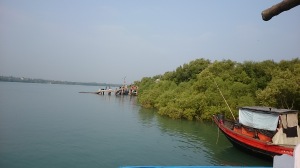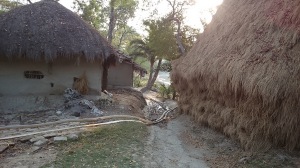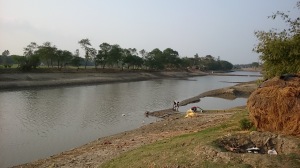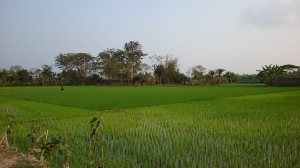Child Labour – a curse on modern society.There has been a 37 % increase in the child labour (age group – Five to nine years) in India over the last decade..
Sunderban Delta – A world heritage site and the world’s largest mangrove forest
Hilsa Conservation

 Hilsa, a must-have Bengali delicacy during monsoon, is facing loss of wild stock due to indiscriminate fishing during ban period, exploitative fishing crafts, absence of alternative livelihood for fishermen during ban period and lack of awareness. “The government of Bangladesh and West Bengal held a joint study and policy dialogue in 2012 and that led to the formulation of National Plan for Action in Bangladesh and notification from the government in the state,” said Dr. Saswati Sen, State Director of WWF-India West Bengal State Office. Dr. Sen said that the notification was introduced in 2013, however, indiscriminate fishing still goes on during ban period and over-catch of hilsa fingerlings is leading to depletion in the stock. Data of from the Department of Fisheries, government of West Bengal, reveal the decline in total catch of hilsa in Hooghly-Bhagirathi river system. As per the report, the catch in 2011-12 was 24121 tonnes, in 2012-13 was 8679 tonnes and in 2013-14 was 10436 as compared to the catch figures decades ago when it was 60,500 tonnes in 2002-03, 40,000 in 2003-04. The recommended size of mesh that is used for catching hilsa should be greater than 90 mm. As per the report of Bay of Bengal Large Marine Ecosystem (BOBLME), however, the average mesh size used in the state normally varies from 75 mm to 85 mm. Widespread usage of smaller mesh nets obstruct the migratory route of hilsa. It makes impossible for hilsa fingerlings to move downstream and prevents adult hilsa from entering into breeding spots thus causing depletion of stock. Large-scale trawling in marine waters is also one of the root causes of depletion of hilsa stock as it has accelerated exploitation of hilsa stock, mentions a report by WWF-India. BOBLME also points out that drying up of rivers and saline intrusion due to reduced water flow from upstream, sedimentation in riverine system also contribute to decline in the stock of hilsa. Discharge from ice plants directly mixes with waters in Digha Mohana or in Champa River at an interval of three to four months cause pollution which also causes depletion of hilsa stock. Fishermen in Bangladesh are provided with alternative livelihood, food, clothes etc but there is no such mechanism in place here. Dr. Saptarshi Biswas, deputy director, Directorate of Fisheries, West Bengal, said, “We have launched a pilot project of providing alternative livelihood to these fishermen. 750 units of fish vending have been installed in nine districts.” Many fishermen who have gained expertise in fishing, however, tend not to opt for other livelihood options which do not involve fishing. Both Dr. Biswas and Dr. Sen pointed out that fish market is demand driven and as long as consumers keep on buying hilsa fingerlings, there will be supplies. Miserably low level of awareness amongst common people leads to over-catch of juvenile hilsa and thus depletion in stock. “We are trying to make both consumers and fishermen aware by distributing leaflets, booklets to KMC markets, advertisements are being played on radio to make people aware,” said Dr. Biswas. Dr. Biswas opined that an incentive-based regulation for the fishermen and raising awareness will be more effective than meting out harsh punishment.
Hilsa, a must-have Bengali delicacy during monsoon, is facing loss of wild stock due to indiscriminate fishing during ban period, exploitative fishing crafts, absence of alternative livelihood for fishermen during ban period and lack of awareness. “The government of Bangladesh and West Bengal held a joint study and policy dialogue in 2012 and that led to the formulation of National Plan for Action in Bangladesh and notification from the government in the state,” said Dr. Saswati Sen, State Director of WWF-India West Bengal State Office. Dr. Sen said that the notification was introduced in 2013, however, indiscriminate fishing still goes on during ban period and over-catch of hilsa fingerlings is leading to depletion in the stock. Data of from the Department of Fisheries, government of West Bengal, reveal the decline in total catch of hilsa in Hooghly-Bhagirathi river system. As per the report, the catch in 2011-12 was 24121 tonnes, in 2012-13 was 8679 tonnes and in 2013-14 was 10436 as compared to the catch figures decades ago when it was 60,500 tonnes in 2002-03, 40,000 in 2003-04. The recommended size of mesh that is used for catching hilsa should be greater than 90 mm. As per the report of Bay of Bengal Large Marine Ecosystem (BOBLME), however, the average mesh size used in the state normally varies from 75 mm to 85 mm. Widespread usage of smaller mesh nets obstruct the migratory route of hilsa. It makes impossible for hilsa fingerlings to move downstream and prevents adult hilsa from entering into breeding spots thus causing depletion of stock. Large-scale trawling in marine waters is also one of the root causes of depletion of hilsa stock as it has accelerated exploitation of hilsa stock, mentions a report by WWF-India. BOBLME also points out that drying up of rivers and saline intrusion due to reduced water flow from upstream, sedimentation in riverine system also contribute to decline in the stock of hilsa. Discharge from ice plants directly mixes with waters in Digha Mohana or in Champa River at an interval of three to four months cause pollution which also causes depletion of hilsa stock. Fishermen in Bangladesh are provided with alternative livelihood, food, clothes etc but there is no such mechanism in place here. Dr. Saptarshi Biswas, deputy director, Directorate of Fisheries, West Bengal, said, “We have launched a pilot project of providing alternative livelihood to these fishermen. 750 units of fish vending have been installed in nine districts.” Many fishermen who have gained expertise in fishing, however, tend not to opt for other livelihood options which do not involve fishing. Both Dr. Biswas and Dr. Sen pointed out that fish market is demand driven and as long as consumers keep on buying hilsa fingerlings, there will be supplies. Miserably low level of awareness amongst common people leads to over-catch of juvenile hilsa and thus depletion in stock. “We are trying to make both consumers and fishermen aware by distributing leaflets, booklets to KMC markets, advertisements are being played on radio to make people aware,” said Dr. Biswas. Dr. Biswas opined that an incentive-based regulation for the fishermen and raising awareness will be more effective than meting out harsh punishment.
b Proper use of rights & freedom/b
Je Suis Charlie
Swedish crime fiction writer urges for controlled freedom of speech , however, he condemns Charlie Hebdo mayhem despite the publication of Mohammed cartoons. An insult doesn’t give you the license to kill… says Nesser
b Grim situation/b
State and public openly flouting the public smoking gudelines laid down by the centre…
b Betwixt and between/b
Despite being a supporter of LGBT activism, my first article on transgenders come late…
Medina was originally a Jewish settlement
Dissertation Project .
Cops to take steps on ‘taxi refusal’ menace…
To curb the menace of ‘Taxi refusal’
http://www.thestatesman.net/news/62982-cops-plan-steps-to-take-on-taxi-refusal-menace.html
The dying art of restoration…
The art of art restoration is fading fast with very few people remaining to take this further. Here’s the story of one such art restorer residing in Howrah.He has been making relentless efforts to rescue these timeless pieces of art by some of the eminent personalities of human history…
http://www.thestatesman.co.in/news/61647-The-dying-art-of-restoration.html















